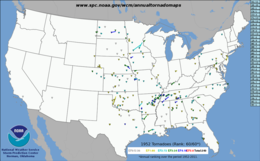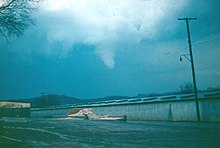Tornadoes of 1952
This page documents the tornadoes and tornado outbreaks of 1952, primarily in the United States. Most tornadoes form in the U.S., although some events may take place internationally. Tornado statistics for older years like this often appear significantly lower than modern years due to fewer reports or confirmed tornadoes.
 Tornado tracks of 1952. | |
| Timespan | 1952 |
|---|---|
| Maximum rated tornado | F4 tornado
|
| Tornadoes in U.S. | 240[1] |
| Damage (U.S.) | Unknown |
| Fatalities (U.S.) | 230 |
| Fatalities (worldwide) | >230 |
Events
Although fewer tornadoes were confirmed than the previous year, 1952 had an exceptionally high number of F4 tornadoes. There was 18 tornadoes that had this rating, mostly due to an unusually intense Mid-March that produced 11 of them along with 11 F3 tornadoes. This outbreak is also what drove the death toll to well over 200 that year. Despite this, no tornadoes were rated F5, leaving the US without an official F5 tornado until the next year.[1]
United States yearly total
| FU | F0 | F1 | F2 | F3 | F4 | F5 | Total |
|---|---|---|---|---|---|---|---|
| 0 | 32 | 82 | 72 | 36 | 18 | 0 | 240 |
January
There were 12 tornadoes confirmed in the US in January.[1]
February
There were 27 tornadoes confirmed in the US in February.[2]
February 13
| FU | F0 | F1 | F2 | F3 | F4 | F5 |
|---|---|---|---|---|---|---|
| 0 | 2 | 5 | 3 | 4 | 1 | 0 |
An intense outbreak of 15 tornadoes struck the Southeast.[3] An F3 tornado moved through rural areas southwest of Berry, Alabama, killing one and injuring 14.[4] Another F3 tornado near Adamsville, Alabama killed one and injured 26.[5] The worst tornado was an F4 twister in Tennessee that moved through Tims Ford State Park and struck the north sides of both Winchester and Decherd, killing three and injuring 44.[6] Overall, the outbreak killed five and injured 102.[3]
February 29
| FU | F0 | F1 | F2 | F3 | F4 | F5 |
|---|---|---|---|---|---|---|
| 0 | 0 | 1 | 5 | 1 | 1 | 0 |

A second February outbreak of tornadoes in the Southeast struck on Leap Day. Eight tornadoes touched down with seven of them being significant.[7] However, the weakest tornado was actually the deadliest in this outbreak. The F1 tornado moved right through the tiny town of Belfast, Tennessee, killing three and injuring 166, the most injuries ever recorded in an F1/EF1 tornado.[8][9] The second worst tornado came next: a violent F4 struck Downtown Fayetteville, Tennessee, killing two and injuring 150.[10] Overall, the outbreak killed five and injured 336.[7]
March
There were 43 confirmed tornadoes in the US in March.[1]
March 21–22
| FU | F0 | F1 | F2 | F3 | F4 | F5 |
|---|---|---|---|---|---|---|
| 0 | 2 | 1 | 6 | 11 | 11 | 0 |
An extremely violent and deadly tornado outbreak struck the Mississippi and Ohio Valleys. Tennessee and Arkansas took the brunt of the outbreak, with two of the F4 tornadoes killing 29 and 50 people in Arkansas respectively while another F4 tornado in Tennessee killed 38. 27 of the 31 tornadoes, 202 of the 209 fatalities, and 1,133 of the 1,212 injuries occurred on March 21 alone. The outbreak also produced 11 F4 tornadoes, which remains the fourth-highest amount of violent tornadoes in one outbreak as of 2020.[1]
April
There were 37 tornadoes confirmed in the US in April.[1]
April 3–5
| FU | F0 | F1 | F2 | F3 | F4 | F5 |
|---|---|---|---|---|---|---|
| 0 | 2 | 7 | 6 | 2 | 0 | 0 |
A large outbreak of 17 tornadoes hit areas from the Southern Plains to the Northeast. On April 4, an F3 tornado hit areas near Jennings and Iota, Louisiana injuring 10. Later, a fatal F2 tornado moved right through Arnaudville, Louisiana, killing four and injuring 33. The next day, 10 tornadoes touched down in the Mid-Atlantic and the Northeast. The strongest was an F3 tornado, that struck multiple populated areas in York County, Pennsylvania, injuring four. In all, the outbreak killed four people and injured 63.[1]
April 20–23
| FU | F0 | F1 | F2 | F3 | F4 | F5 |
|---|---|---|---|---|---|---|
| 0 | 6 | 3 | 0 | 0 | 1 | 0 |
A minor outbreak of 10 tornadoes occurred across the Great Plains and the Lower Mississippi Valley. On April 21, an F4 tornado tracked 2.3 miles southeastward between Crawford and McGregor, Texas. All the other tornadoes were weak and none of the tornadoes caused any casualties.[1]
May
There were 34 tornadoes confirmed in the US in May.[1]
May 10–11
| FU | F0 | F1 | F2 | F3 | F4 | F5 |
|---|---|---|---|---|---|---|
| 0 | 0 | 3 | 1 | 2 | 0 | 0 |
A series of six destructive tornadoes struck the Southeast. On May 10, an F3 tornado moved through Five Forks, South Carolina as well as areas near Glenn Springs, killing two and injuring four. The next morning, another F3 tornado moved directly through Alapaha, Georgia, injuring 10. In the end, the outbreak killed two and injured 20.[1]
May 21–24
| FU | F0 | F1 | F2 | F3 | F4 | F5 |
|---|---|---|---|---|---|---|
| 0 | 3 | 7 | 5 | 0 | 1 | 0 |
An outbreak of 16 tornadoes affected areas from the Great Plains to the Southeast. On May 22, a long-tracked, .25 mile wide F4 tornado tore through areas just northeast of Lawrence, Kansas to the western suburbs of Kansas City, Kansas. The towns of Linwood and Edwardville were particulary hard hit, as dozens of homes were destroyed, including the home of a bank president that was leveled. Tornado researcher Thomas P. Grazulis indicated that there the tornado, which injured three people, may have reached F5 intensity as well.[11] An F2 tornado then struck Lake Lotawana near Lee's Summit and Lone Jack, Missouri southeast of Kansas City, Missouri, injuring another person. Overall, although there were no fatalities, eight people were injured by the tornadoes.[1]
June
There were 34 tornadoes confirmed in the US in June.[1]
June 23–24
| FU | F0 | F1 | F2 | F3 | F4 | F5 |
|---|---|---|---|---|---|---|
| 0 | 2 | 0 | 3 | 1 | 1 | 0 |
Several intense tornadoes touched down across the Great Plains. On June 23, an F4 tornado passed between Cleghorn and Meriden, Iowa before striking Larrabee, injuring four. Later, an extremely long-tracked F2 tornado traveled 104.8 miles through mostly rural areas before ending in the southwestern suburbs Minneapolis, Minnesota, injuring 10. Next, a fatal F3 tornado struck Centuria, Wisconsin, killing two and injuring six. The next day, another long-tracked F2 tornado struck Minneapolis, only this time it moved directly through Downtown. A total of 15 people were injured along the twister's 70.9 mile path. Overall, the outbreak produced seven tornadoes that killed two and injured 35.[1]
July
There were 27 tornadoes confirmed in the US in July.[1]
July 1–2
| FU | F0 | F1 | F2 | F3 | F4 | F5 |
|---|---|---|---|---|---|---|
| 0 | 0 | 2 | 1 | 1 | 1 | 0 |
Three significant tornadoes struck North Dakota on July 1. The strongest, as well as the only one to cause casualties, was a long-tracked F4 tornado that moved through Arena and Tuttle killing one and injuring 26. Two additional F1 tornadoes touched down the next day in Minnesota and Iowa as well.[1]
July 19
| FU | F0 | F1 | F2 | F3 | F4 | F5 |
|---|---|---|---|---|---|---|
| 0 | 0 | 0 | 1 | 2 | 0 | 0 |
Three strong tornadoes touched down across the northern section of the United States. The first one was an early morning F2 tornado that hit Corry, Pennsylvania. Later, in the evening, a long-tracked F3 tornado moved through Baker and south of Mound, Montana. The final tornado was a shorter, but fatal F3 tornado that hit Wilbaux, Montana before moving into rural Golden Valley County, North Dakota, killing one and injuring two. This was the only killer tornado of the three.[1]
August
There were 16 tornadoes confirmed in the US in August.
August 12–16
| FU | F0 | F1 | F2 | F3 | F4 | F5 |
|---|---|---|---|---|---|---|
| 0 | 0 | 3 | 2 | 1 | 1 | 0 |
A slowly progressing, but destructive series of seven tornadoes moved across the country. The worst and strongest tornadoes occurred on August 13 in Nebraska. A massive, long-tracked 1300 yard wide F3 tornado that moved through Richland, Edholm, Colon, and Yutan, injuring one. Later, an even stronger F4 tornado moved directly through Memphis and Ashland, injuring 20. The 21 injuries were the only casualties from the period.[1]
August 21
| FU | F0 | F1 | F2 | F3 | F4 | F5 |
|---|---|---|---|---|---|---|
| 0 | 0 | 0 | 1 | 0 | 0 | 0 |
An isolated, but strong F2 tornado struck the southwest side of Sedalia, Missouri, lifting just before reaching the downtown area. One person was killed and 13 others were injured.[1]
September
There was 1 tornado confirmed in the US in September.[1]
October
There were no tornadoes confirmed in the US in October, the first time that no tornadoes were recorded during a month since 1950.[1]
November
There were 6 tornadoes confirmed in the US in November.[1]
December
There were 3 tornadoes confirmed in the US in December.[1]
December 20
| FU | F0 | F1 | F2 | F3 | F4 | F5 |
|---|---|---|---|---|---|---|
| 0 | 1 | 0 | 0 | 0 | 0 | 0 |
A weak F0 tornado touched down briefly on Oakdale Canyon near Santa Clarita, California. There were no casualties.[1]
See also
- Tornado
- Tornadoes by year
- Tornado records
- Tornado climatology
- Tornado myths
- List of tornado outbreaks
- List of F5 and EF5 tornadoes
- List of North American tornadoes and tornado outbreaks
- List of 21st-century Canadian tornadoes and tornado outbreaks
- List of European tornadoes and tornado outbreaks
- List of tornadoes and tornado outbreaks in Asia
- List of Southern Hemisphere tornadoes and tornado outbreaks
- List of tornadoes striking downtown areas
- Tornado intensity
References
- "Tornado History Project: 1952". www.tornadohistoryproject.com. Retrieved 9 July 2020.
- "February 1952 Tornadoes". Tornado History Projects. Storm Predicition Center. Retrieved 8 July 2020.
- "February 13, 1952 Tornadoes". Tornado History Projects. Storm Predicition Center. Retrieved 8 July 2020.
- "Alabama F3". Tornado History Projects. Storm Predicition Center. Retrieved 8 July 2020.
- "Alabama F3". Tornado History Projects. Storm Predicition Center. Retrieved 8 July 2020.
- "Tennessee F4". Tornado History Projects. Storm Predicition Center. Retrieved 8 July 2020.
- "February 29, 1952 Tornadoes". Tornado History Projects. Storm Predicition Center. Retrieved 8 July 2020.
- "Tennessee F1". Tornado History Projects. Storm Predicition Center. Retrieved 8 July 2020.
- http://www.tornadohistoryproject.com/tornado/F1
- "Tennessee F4". Tornado History Projects. Storm Predicition Center. Retrieved 8 July 2020.
- Grazulis, Thomas P. (July 1993). Significant Tornadoes 1680-1991. A Chronology and Analysis of Events. St. Johnsbury, VT: The Tornado Project of Environmental Films. ISBN 1-879362-03-1.